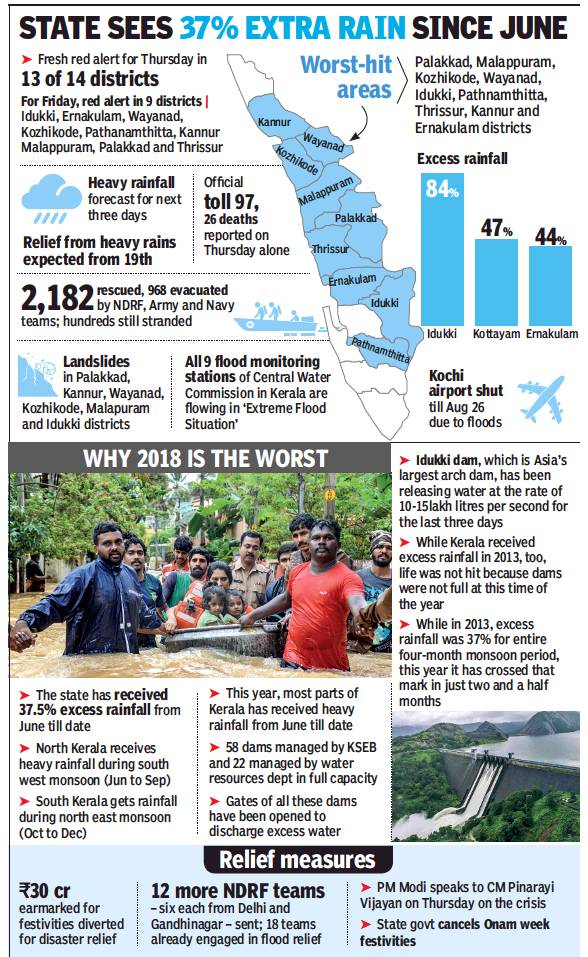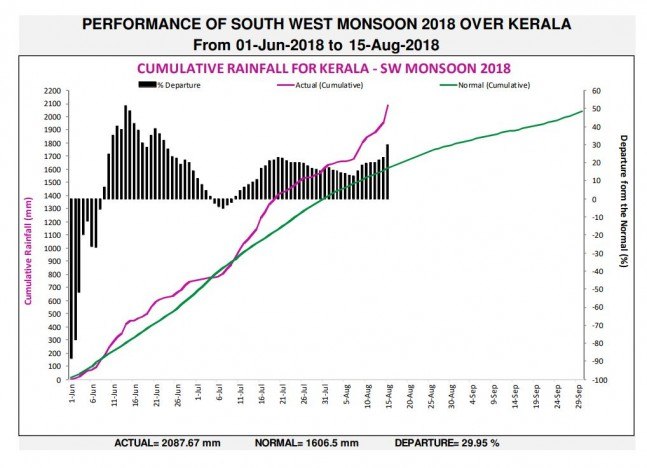Floods in Kerala: a history
(→1924 vis-à-vis 2018) |
|||
| Line 9: | Line 9: | ||
[[Category:Kerala |K ]] | [[Category:Kerala |K ]] | ||
[[Category:Places |K ]] | [[Category:Places |K ]] | ||
| − | [[Category:Natural | + | [[Category:Natural Disasters |K ]] |
=The floods of 2018= | =The floods of 2018= | ||
Revision as of 09:45, 18 August 2018
This is a collection of articles archived for the excellence of their content. |
Contents |
The floods of 2018
Causes
Rapid release of dam water?
Centre To Send 35 More NDRF Teams
The Kerala crisis could have been contained had the state “gradually released” waters from at least 30 dams, officials here said, adding that the local authorities failed to foresee the imminent danger with high rain predictions.
“Such floods have probably recurred after 100 years, exposing the state’s unprofessionally-run reservoir management system and unpreparedness on disaster mitigation and disaster resilience,” an official pointed out.
Kerala has also not taken many of the steps for disaster risk reduction as per the National Disaster Management policy. This despite the fact that the state was ranked in a recent survey among 10 states most vulnerable to flood hazards.
At a meeting of the National Crisis Management Committee here on Thursday, the Centre decided to dispatch an additional 35 teams of the National Disaster Response Force, each comprising 40-45 personnel, taking the total to 53. The meeting was chaired by the cabinet secretary and attended by the chiefs of Army, Air Force, Navy and secretaries of defence, home and water resources.
The deployment of more manpower and equipment is part of the Centre’s efforts to scale up the rescue and relief operations. Despite the fact that Kerala is an exception among 30 states and Union Territories to have raised at least one battalion (1,100 personnel) of State Disaster Response Force, continuous rains are making rescue work difficult.
Kerala is also a laggard among states surveyed by the Centre on risk governance. These states have been assessed on the progress made in setting up institutional mechanisms for risk resilience. Every state is to set up its state and disaster management authority, as mandated by the Disaster Management Act.
Damage
Till mid- August

From: Damage to crop, property in Kerala floods pegged at ₹8,000 crore so far, August 17, 2018: The Times of India
The floods in Kerala are estimated to have damaged crops and properties worth over Rs 8,000 crore even as a fresh red alert was sounded in 13 of the 14 districts in the state. All nine flood-monitoring stations of the Central Water Commission have notified ‘extreme flood situation’.
NGOs have joined 52 teams of the Army, Air Force, Navy, Coast Guard and NDRF in relief and rescue operations in flood-ravaged Kerala but it became evident on Thursday that the scale of the disaster was greater than the current efforts to cope with it.
Pathanamthitta district continued to remain the worst-affected with thousands of people stranded at their homes in Ranni, Aranmula and Kozhencherry towns. Water levels in several parts of Pathanamthitta, Ernakulam and Thrissur districts rose to as high as 20 feet, turning streets into deep lakes. CM Pinarayi Vijayan spoke to PM Modi and other central leaders again on Thursday to request more help.
Landslides were reported in Kannur, Wayanad, Kozhikode, Malappuram and Idukki districts. Munnar remained submerged for the third day while the Sabarimala shrine was cut off.
Meanwhile, the Supreme Court directed Mullaperiyar dam authorities to chalk out contingency plan to meet any crisis due to release of water and also consider reducing the water level to 139 feet from the present 142 feet. A bench of Chief Justice Dipak Misra and Justice Indu Malhotra asked Tamil Nadu and Kerala to work harmoniously to get over the problem. Earlier, advocate Manoj George had contended release of water from the dam “at the whims and fancies of Tamil Nadu for extraneous reasons” is a threat to the life of people living downstream.
1924 vis-à-vis 2018

From 1 June 2018 to 15 August 2018.
Cumulative rainfall for Kerala- South West Monsoon 2018
From: Prabhash K Dutta, Why Kerala fears repeat of 1924 havoc in 2018 rainfall, August 16, 2018: India Today
According to district-wise India Meteorological Department data for rainfall this monsoon, 283 of 640 or nearly 45 per cent districts of the country are facing deficient rain. But Kerala is a contrasting case where 12 of 14 districts are facing heavy rainfall and floods. The heavy rainfall has forced the opening of shutters of all the major dams.
People in the state fear a repeat of what they call "the Great Flood of 99". This is a reference to Malayalam Era 1099 corresponding to 1924 of Gregorian calendar, the one which is most commonly used.
Kerala Chief Minister Pinarayi Vijayan on Tuesday, August 14, said, "This is the worst monsoon disaster since 1924."
On Thursday, Union minister KJ Alphons, who is from Kerala, echoed almost verbatim Vijayan's quote: "These are the worst floods since 1924."
The southwest monsoonal rainfall for 1924 remains the highest in the recorded history. A total of 3,368 mm water poured from the sky. In a spell of rainfall for three continuous weeks, most parts of Kerala were submerged.
Periyar river flooded large areas as Mullaperiyar dam had gave way to water pressure. The floodwater washed away an entire hill called Karinthiri Malai. It was a total disaster during that rainy season. Official data are not available but 1,000-plus people were said to have died in the great flood of 1924.
This monsoon it hasn't poured as much as 1924. According to the met department, the cumulative rainfall for Kerala from southwest monsoon between June 1 and August 15 was 2,087.67 mm, a departure of nearly 30 per cent from the normal 1,606.05 mm rainfall. But still a couple of weeks of active monsoon are left and the 1924 record could be breached.
But Kerala's case is a departure. The reason is that the weather scientists are of the view that southwest monsoon has 'dried' in the past 115 years. They have analysed the rainfall data from 1901 to 2016 and found a declining trend in monsoonal rain.
However, there is another Kerala specific trend, which suggests a rising rainfall quantity in the state in the past few years. Kerala seems to be having a cyclical pattern of monsoonal rainfall. The 2013 rainfall in Kerala was the highest in recent years.
Kerala received 2,561.2mm of monsoonal rain in 2013. The downpour volume declined thereafter reaching an ebb in 2015, when the state faced a drought-like situation. The southwest monsoonal rainfall has been increasing after 2015. Total southwest monsoonal rainfall last year was 1,855.9 mm, a deficiency of nine per cent from the average rainfall which is considered normal.
But the spike in the amount of rainfall this year has been surprising. Kerala has reported more than 215 landslides due to excessive rainfall. Roads of over 10,000 km length have been damaged. Around 20,000 homes have been destroyed and more than 75 people have died this monsoon season in Kerala.